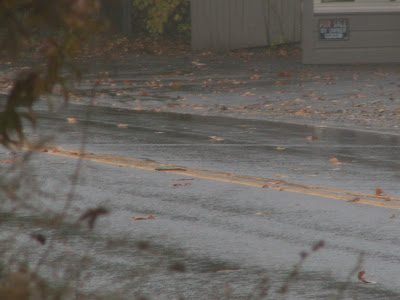When a car pulls up to a stop sign, let's say the stop sign on Playhouse Lane, where it intersects with Route 212, the driver is supposed to be able to see to the left and to the right, in order to make a safe turn into moving traffic. In this blog post, we will explore the standards for various types of vehicles at various intersections.
According to the Ulster County Access Management Guidelines cited in the last post on this blog, the recommended minimum sight distance for a passenger car, entering a two lane major road (Route 212 is a major road,) on which the speed limit is 30 MPH, is 360 feet to the left, and 260 feet to the right. Please note that this guideline is for cars leaving driveways, not roads. But you might ask yourself whether a car at a stop sign is in any way different from a car leaving a driveway.
Also, you may ask exactly what these measurements mean. The cited guidelines show the front of the vehicle ten feet behind the edge of the pavement, where it meets the other street. This means that where the pavement of Route 212 intersects the pavement of Playhouse Lane, measure ten feet back on Playhouse Lane. It is this point that we must use for our "eye."
From our eye point, we measure:
- to the left, 360 feet in a straight line (which will cut across the unpaved land on the corner) to the center of the near traffic lane, which is the traffic lane on Route 212 moving west (from left to right).
- to the right, 260 feet in a straight line to the center of the far traffic lane, which is the traffic lane on Route 212 moving east (from right to left).
AASHTO is The American Association of State Highway and Transportation Officials. AASHTO's guidelines for Intersection Sight Distance, in feet, are as follows:
On a road with design speed of 30 MPH, for a car turning left onto that road, sight distance must be 309 feet to the left, meaning that a car approaching from the left must be visible at 309 feet. And for the same left turn, a car approaching from the right must be visible at 380 feet.
Now let us look at the RUPCO intersection study, as it was presented in the Draft Environmental Impact Study. RUPCO claims that the current sight distance to the left, meaning to the center of the lane running from east to west, on Route 212, from ten feet back from the edge of the pavement joining Route 212 to Playhouse lane, is 150 feet, and that the recommended sight distance for a left turn and looking left is 390 feet. (see Table 12, RUPCO DEIS.)
Now let us look at the RUPCO intersection study, as it was presented in the Draft Environmental Impact Study. RUPCO claims that the current sight distance to the left, meaning to the center of the lane running from east to west, on Route 212, from ten feet back from the edge of the pavement joining Route 212 to Playhouse lane, is 150 feet, and that the recommended sight distance for a left turn and looking left is 390 feet. (see Table 12, RUPCO DEIS.)
I have measured this sight distance, and found it to be only 111 feet:
Here is a photo of a stick I placed in the road, exactly 150 feet to the east (left) of the point at which the center of Playhouse Lane intersects with the yellow lines in the center of Route 212:
 Here is another photo, this one of an approaching car, approximately even with the stick on the yellow line. As you can see, the front of the car has not yet cleared the bushes. Also, the headlights, which were necessary due to the heavy rain, makes the car more visible. The standard for whether a car is "visible" is whether its roof can be seen. The roof of this car cannot be seen here, therefore this sight line comes in well below the 150 feet reported by RUPCO in the Draft Environmental Impact Statement.
Here is another photo, this one of an approaching car, approximately even with the stick on the yellow line. As you can see, the front of the car has not yet cleared the bushes. Also, the headlights, which were necessary due to the heavy rain, makes the car more visible. The standard for whether a car is "visible" is whether its roof can be seen. The roof of this car cannot be seen here, therefore this sight line comes in well below the 150 feet reported by RUPCO in the Draft Environmental Impact Statement.
RUPCO also includes the number 400 in parentheses and in a legend below the table:
"(X) = Estimated improved conditions."
This is the really big problem with this study. Who is authorized to improve this unsafe, 111 foot sight distance at all? The answer is: not RUPCO. So, why does RUPCO include the estimated improved conditions? I can't say for sure, but it seems that RUPCO would not be smart to include the distance of 150 when 390 is recommended. So, they suggest that the distance will increase, conveniently just ten feet more than the recommended minimum safe distance.
Herein lies the problem: the assumption that the sight distance will be increased. How will that happen? Who will make it happen? Please go to the next post to explore a solution.

From your work it is sufficent to say that the County which receives receives State money for highways that in turn comes from the Fed block grant to NY is in jeopardy for faulty and poentntionally dangerous highway safety design. Uniform Guidelines for State Highway Safety Programs Highway Safety Program Guideline No. 15. ... The State Highway Safety Office (SHSO) should provide the leadership, training and technical assistance necessary to: ... www.nhtsa.dot.gov/nhtsa/whatsup/tea21/tea21programs/pages/TrafficEnfment.htm -
ReplyDelete